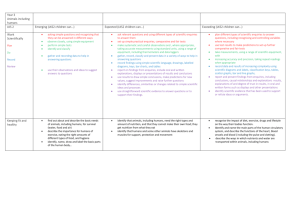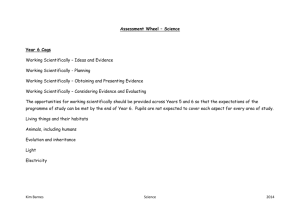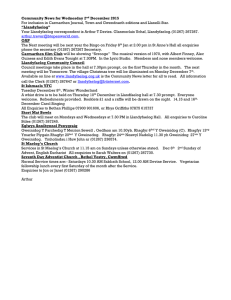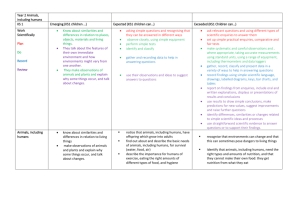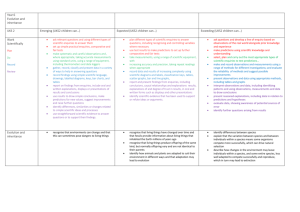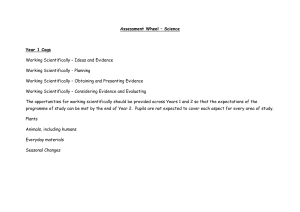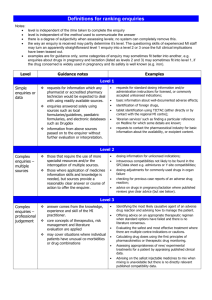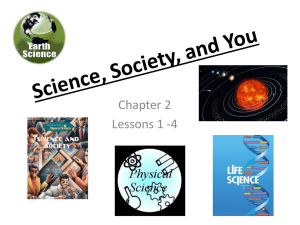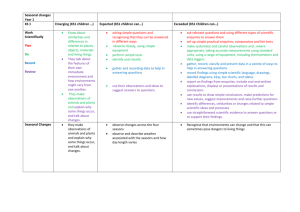Year 5 Science objectives
advertisement
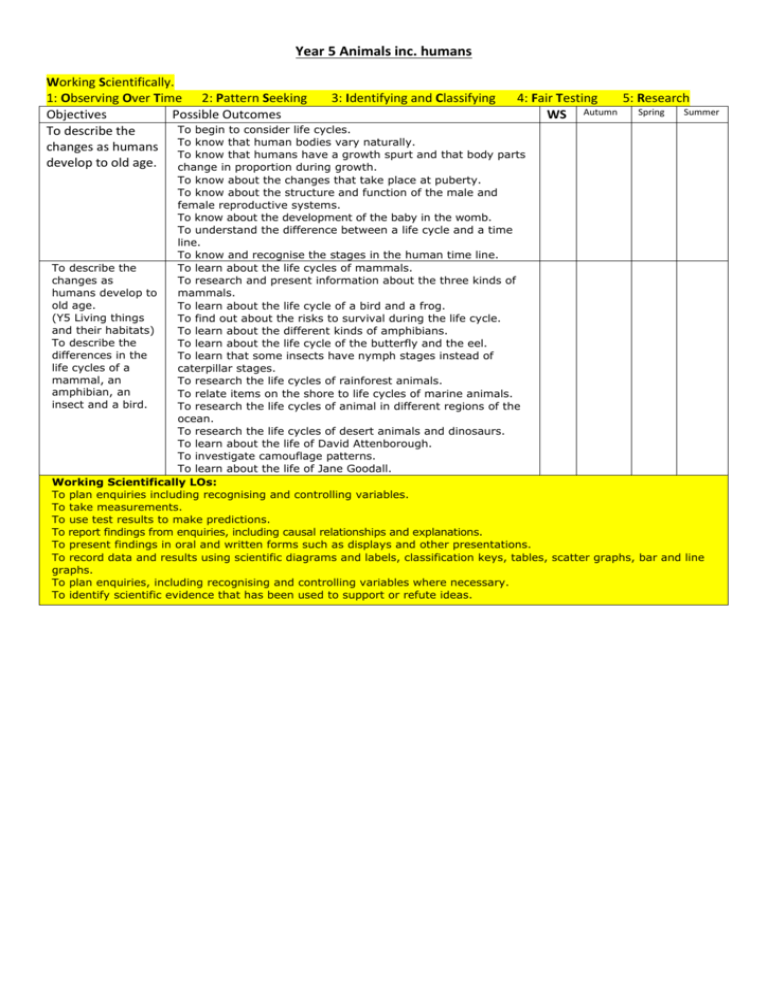
Year 5 Animals inc. humans Working Scientifically. 1: Observing Over Time 2: Pattern Seeking 3: Identifying and Classifying 4: Fair Testing 5: Research Autumn Spring Summer Objectives Possible Outcomes WS To begin to consider life cycles. To describe the changes as humans To know that human bodies vary naturally. To know that humans have a growth spurt and that body parts develop to old age. change in proportion during growth. To know about the changes that take place at puberty. To know about the structure and function of the male and female reproductive systems. To know about the development of the baby in the womb. To understand the difference between a life cycle and a time line. To know and recognise the stages in the human time line. To describe the To learn about the life cycles of mammals. changes as To research and present information about the three kinds of humans develop to mammals. old age. To learn about the life cycle of a bird and a frog. (Y5 Living things To find out about the risks to survival during the life cycle. and their habitats) To learn about the different kinds of amphibians. To describe the To learn about the life cycle of the butterfly and the eel. differences in the To learn that some insects have nymph stages instead of life cycles of a caterpillar stages. mammal, an To research the life cycles of rainforest animals. amphibian, an To relate items on the shore to life cycles of marine animals. insect and a bird. To research the life cycles of animal in different regions of the ocean. To research the life cycles of desert animals and dinosaurs. To learn about the life of David Attenborough. To investigate camouflage patterns. To learn about the life of Jane Goodall. Working Scientifically LOs: To plan enquiries including recognising and controlling variables. To take measurements. To use test results to make predictions. To report findings from enquiries, including causal relationships and explanations. To present findings in oral and written forms such as displays and other presentations. To record data and results using scientific diagrams and labels, classification keys, tables, scatter graphs, bar and line graphs. To plan enquiries, including recognising and controlling variables where necessary. To identify scientific evidence that has been used to support or refute ideas. Year 5 Properties of materials Working Scientifically. 1: Observing Over Time Objectives 2: Pattern Seeking 3: Identifying and Classifying Possible Outcomes To compare and group together everyday materials on the basis of their properties, including their hardness, solubility, transparency, conductivity (electrical and thermal), and response to magnets. To give reasons, based on evidence from comparative and fair tests, for the particular uses of everyday materials. To use knowledge of solids, liquids and gases to decide how mixtures might be separated. To identify the properties of solids, liquids and gases and provide examples. To show how a simple electrical circuit is constructed. To devise and carry out an investigation into the hardness of materials. To devise and carry out an investigation into the electrical conductivity of materials. To devise and carry out an investigation into the thermal conductivity of materials. To devise and carry out an investigation into the response to magnets of materials. To link the properties of materials with their everyday uses. To use research skills to find out more information. To devise and carry out an investigation into the waterproof properties of fabrics. To devise and carry out an investigation into the water absorbing properties of fabrics, bricks and rocks. To link the properties of materials with their uses. To learn about porous materials, and that soil has air in it. To understand how a sieve works. To know how particles of different sizes can form different layers of sediment, and that this process can be used to separate materials. To understand that when some mixtures mix with water some of their components may dissolve. To identify substances which are soluble and insoluble in water. 4: Fair Testing 5: Research WS Autumn Spring Summer To compare and group together everyday materials on the basis of their properties, including their hardness, solubility, transparency, conductivity (electrical and thermal), and response to magnets. To use knowledge of solids, liquids and gases to decide how mixtures might be separated. To demonstrate that dissolving, mixing and changes of state are reversible changes. To use knowledge of solids, To know that evaporation can be used as a liquids and gases to decide means of recovering a dissolved solid. how mixtures might be To learn how mixing, dissolving, filtering and separated. evaporation can be used in separating To demonstrate that materials. dissolving, mixing and changes of state are reversible changes. Working Scientifically LOs: To plan enquiries including recognising and controlling variables. To take measurements. To use test results to make predictions. To report findings from enquiries, including causal relationships and explanations. To present findings in oral and written forms such as displays and other presentations. To record data and results using scientific diagrams and labels, classification keys, tables, scatter graphs, bar and line graphs. To plan enquiries, including recognising and controlling variables where necessary. To identify scientific evidence that has been used to support or refute ideas. Year 5 Earth and space Working Scientifically. 1: Observing Over Time Objectives 2: Pattern Seeking 3: Identifying and Classifying 4: Fair Testing 5: Research Possible Outcomes WS Autumn Spring Summer To describe the Sun, Earth and Moon as approximately spherical bodies. To use the idea of the Earth’s rotation to explain day and night. To study evidence for a spherical Earth. To compare the sizes of Earth, Moon and Sun. To understand that the Earth rotates and relate the Earth’s rotation to the measurement of time. To investigate the movement of the Sun across the sky. To describe the movement of the Earth relative to the Sun in the solar system. To use the idea of the Earth’s rotation to explain day and night. To locate the different time zones. To understand that the axis of the Earth tilts. To know how the Earth moves around the Sun. To relate the change in sunrise times to the angle of tilt, and the Earth’s position on its orbit to the seasons. To describe the movement of the Earth relative to the Sun in the solar system. To describe the movement of the Moon relative to the Earth. To relate the activities of living things and the weather to the angle of tilt, and the Earth’s position on its orbit to the seasons. To discover how the phases of the Moon occur. To understand that as the Earth moves around the Sun, the Moon also moves around the Earth. To know the positions of the planets and the asteroid belt in the solar system. To understand how moons are believed to have formed and to know the planets that have them. To understand that there are different kinds of stars. To understand the arrangement of stars in constellations. To understand how scientists look for planets around stars. To understand that the Sun is a star in a galaxy. To understand the relationship of galaxies to the universe. To understand the idea of the geocentric solar system and that the idea had flaws. To study the life and work of Copernicus and Galileo. To understand that scientists use the work of others as the basis for their own work. Working Scientifically LOs: To plan enquiries including recognising and controlling variables. To take measurements. To use test results to make predictions. To report findings from enquiries, including causal relationships and explanations. To present findings in oral and written forms such as displays and other presentations. To record data and results using scientific diagrams and labels, classification keys, tables, scatter graphs, bar and line graphs. To plan enquiries, including recognising and controlling variables where necessary. To identify scientific evidence that has been used to support or refute ideas. Year 5 Living things Working Scientifically. 1: Observing Over Time Objectives To describe the life process of reproduction in some plants. 2: Pattern Seeking 3: Identifying and Classifying 4: Fair Testing 5: Research Possible Outcomes WS Autumn Spring Summer To ascertain the accumulated knowledge of plants. To investigate the processes that take place in germination. To investigate the structure of single and composite flowers. To identify the pollen producing and pollen receiving parts of the flower. To identify pollinating insects. To identify wind pollinated plants and importance of wind pollination to cereal crops. To explore the diversity of seed dispersal. To discuss the ways in which seeds are dispersed. To distinguish between ephemerals, annuals, biennials, herbaceous perennials and woody perennials. To describe in detail the plants in a habitat using botanical vocabulary. To explore how plants have adapted to life in a rainforest. To explore how seaweeds are adapted for shore life. To learn about how plant life cycles are adapted for desert conditions. To investigate how stems absorb water from the ground. To study prehistoric plants. To investigate a ‘living fossil’. To learn about Theophrastus, John Ray and Joseph Banks and their work on plants. To learn about Kew Gardens. To use a knowledge of plants to set up a garden, flower bed or vegetable plot. Working Scientifically LOs: To plan enquiries including recognising and controlling variables. To take measurements. To use test results to make predictions. To report findings from enquiries, including causal relationships and explanations. To present findings in oral and written forms such as displays and other presentations. To record data and results using scientific diagrams and labels, classification keys, tables, scatter graphs, bar and line graphs. To plan enquiries, including recognising and controlling variables where necessary. To identify scientific evidence that has been used to support or refute ideas. Year 5 Properties of materials Working Scientifically. 1: Observing Over Time 2: Pattern Seeking Objectives Possible Outcomes 3: Identifying and Classifying To explain that some changes result in the formation of new materials, and that this kind of change is not usually reversible. To identify a range of reversible changes. To introduce the concept that some changes form new materials. To discover how invisible ink works and investigate suitable materials for invisible inks. To observe changes that take place when water and plaster of Paris are mixed. To explain that some changes result in the formation of new materials, and that this kind of change is not usually reversible, including changes associated with burning. To explain that some changes result in the formation of new materials, and that this kind of change is not usually reversible, including changes associated with burning and the action of acid on bicarbonate of soda. To investigate the effect of heat on foods. To compare the effect of heat on dough. To investigate properties of biscuits made in different proportions of ingredients and different baking times. 4: Fair Testing 5: Research WS Autumn Spring Summer To consider the effect of burning on a range of materials. To consider the changes that take place when a candle burns. To know the changes that take place when vinegar is added to bicarbonate. To know the effect of the gas produced on a flame. To understand the science behind the techniques of fighting fires. To know that sometimes a gas is produced by an irreversible reaction. To know the effect of diluting the vinegar on its reaction with bicarbonate of soda. To learn about the processes taking place in a volcanic eruption. To explain that some To learn where rusting takes place and consider the changes result in the factors that may cause rusting. formation of new To know how to prevent rusting. materials, and that To understand the processes and work involved in this kind of change is using iron beneficially. not usually reversible. To learn how polymers are created. To understand the effect of temperature on the initial reaction. To investigate the properties of plastics and compare them to other materials. To find out about the life and work of a scientist and the impact of their discoveries. Working Scientifically LOs: To plan enquiries including recognising and controlling variables. To take measurements. To use test results to make predictions. To report findings from enquiries, including causal relationships and explanations. To present findings in oral and written forms such as displays and other presentations. To record data and results using scientific diagrams and labels, classification keys, tables, scatter graphs, bar and line graphs. To plan enquiries, including recognising and controlling variables where necessary. To identify scientific evidence that has been used to support or refute ideas. Year 5 Forces Working Scientifically. 1: Observing Over Time 2: Pattern Seeking Objectives Possible Outcomes To explain that unsupported objects fall towards the Earth because of the force of gravity acting between the Earth and the falling object. To identify the effects of air resistance, water resistance and friction, that act between moving surfaces. To recognise that some mechanisms, including levers, pulleys and gears, allow a smaller force to have a greater effect. 3: Identifying and Classifying 4: Fair Testing 5: Research WS Autumn Spring Summer To revise how magnets attract some but not all metals. To investigate magnetic forces acting at a distance. To identify forces and their direction. To know that the force that pulls an object down is its weight in Newtons. To use research skills to find out how a scientist developed ideas. To know that gravity isn’t just an Earth phenomenon. To compare the work of Galileo and Newton. To know that air produces a force that opposes motion. To know that parachutes slow down the speed that an object falls. To know that the size of a parachute changes how quickly an object falls. To understand the differences between the resistance to motion of air and water. To know that friction slows down movement. To know that a Newton meter can be used to measure friction forces. To know that drag forces will stop an object unless a force is used to push it forward. To know that brakes must have high friction to make them effective. To know how speed and other factors affect how quickly a car can stop. To know some simple machines that are used to assist movement. To know how some simple machines and how the length of a lever can make moving a load easier. Working Scientifically LOs: To plan enquiries including recognising and controlling variables. To take measurements. To use test results to make predictions. To report findings from enquiries, including causal relationships and explanations. To present findings in oral and written forms such as displays and other presentations. To record data and results using scientific diagrams and labels, classification keys, tables, scatter graphs, bar and line graphs. To plan enquiries, including recognising and controlling variables where necessary. To identify scientific evidence that has been used to support or refute ideas.
